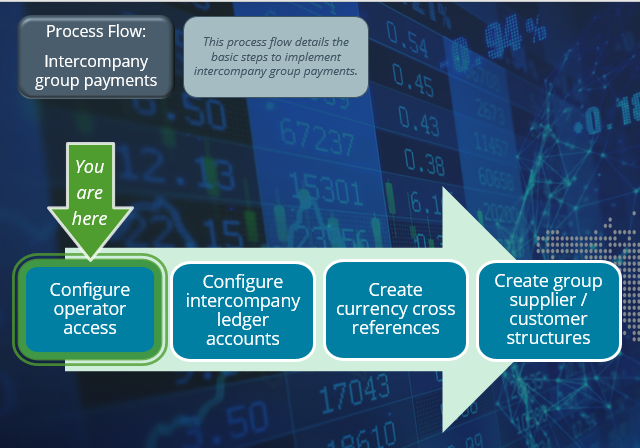Security per Company

This program lets you restrict operator access to companies for which intercompany group payments can be processed.
The program title bar shows whether you are configuring operator access for Accounts Payable or Accounts Receivable group payments.
Exploring
This program can't be run standalone and is accessed from the following program(s):
-
Operator Maintenance
From the Configure option at the AP access control or AR access control fields within the Security tab.
This comprises a primary customer and secondary customers (i.e. one or more associated downstream customers).
Group customers simplify the payments process by letting you process a single large payment against a group customer (the primary and secondary customers) instead of having to make smaller individual payments.
Group customers are maintained using the AR Customer Group Maintenance program (Program List > Accounts Receivable > Transaction Processing).
This comprises a primary supplier and one or more associated downstream suppliers (i.e. secondary suppliers). These groups are used to create and process group payments.
Group Suppliers are maintained using the AP Group Suppliers program (Program List > Accounts Payable > Setup).
An intercompany group payment affects two or more SYSPRO companies and involves the Accounts Payable and Accounts Receivable modules.
The transaction is processed in the primary company and involves payments to secondary companies for Accounts Payable or payments from secondary companies for Accounts Receivable.
All secondary SYSPRO companies must be located on the same SYSPRO server as the primary SYSPRO company.
This is the customer against which a single payment is processed (i.e. the recipient of the aggregate payment). This single remittance is known as a group payment.
When processing intercompany group payments, this is the customer in the primary SYSPRO company against which payments from multiple secondary customers either in the same or secondary SYSPRO company is processed.
Primary customers are created and maintained using the AR Customer Group Maintenance program (Program List > Accounts Receivable > Setup).
This is the supplier against which the single remittance for payments to multiple secondary suppliers is processed (i.e. recipient of the aggregate payment). This single remittance is known as a group payment.
When processing group/intercompany group payments, this is the supplier in the primary SYSPRO company against which payments to multiple secondary suppliers either in the same or secondary SYSPRO company are processed.
Primary suppliers are created and maintained using the AP Group Suppliers program (Program List > Accounts Payable > Setup).
This is the company in which you process the group/intercompany group payment.
This is also the company where the primary customer (for Accounts Receivable) or primary supplier (for Accounts Payable) is located.
All secondary SYSPRO companies must be located on the same SYSPRO server as the primary SYSPRO company.
This is a customer to whom a portion of the payment that was received by the primary customer, is allocated. All secondary customers and the primary customer they are linked to form a customer group. The payment made to the primary customer is referred to as a Accounts Receivable group payment.
A secondary customer can be in the primary or secondary SYSPRO company.
Customers for group payments are defined using the AR Customer Group Maintenance program (Program List > Accounts Receivable > Setup).
This supplier is paid together with its associated primary supplier via a single remittance (i.e. group payment).
Suppliers for group payments are defined using the AP Group Suppliers program (Program List > Accounts Payable > Setup).
Secondary SYSPRO companies are updated by the transaction that is initiated and processed in the primary SYSPRO company.
All secondary SYSPRO companies must be located on the same SYSPRO server as the primary SYSPRO company.
Solving

Why don't you drop us a line with some useful information we can add here?
Using
-
Columns in a listview are sometimes hidden by default. You can reinstate them using the Field Chooser option from the context-sensitive menu (displayed by right-clicking a header column header in the listview). Select and drag the required column to a position in the listview header.
-
Press Ctrl+F1 within a listview or form to view a complete list of functions available.
Referencing
| Column | Description |
|---|---|
|
Company |
This indicates the company code. |
|
Company name |
This indicates the description of the company. |
|
Access type |
This indicates the level of access granted to the operator. |
|
List |
Select the Configure List hyperlink to define the list of companies to which the operator has access or is denied access. This option only applies if you selected Allowed List or Denied List within the Access type column. |
|
Company access |
This indicates whether the operator has permission to log into the company. |
This saves the details you have entered or changed and closes the window.
Available Companies
This gives the operator access to view or process intercompany payments to the selected companies.
This gives the operator access to view or process intercompany payments for all listed companies.
| Column | Description |
|---|---|
|
Company |
This indicates the companies to which the operator doesn't have access. |
|
Name |
This indicates the description of the company. |
Assigned Companies
This removes the selected companies from the operator (i.e. the operator will no longer be able to view or process intercompany payments to the selected companies).
This removes all companies from the operator (i.e. the operator will no longer be able to view or process intercompany payments for all listed companies).
| Column | Description |
|---|---|
|
Company |
This indicates the companies to which the operator has access. |
|
Name |
This indicates the description of the company. |
Copyright © 2025 SYSPRO PTY Ltd.

